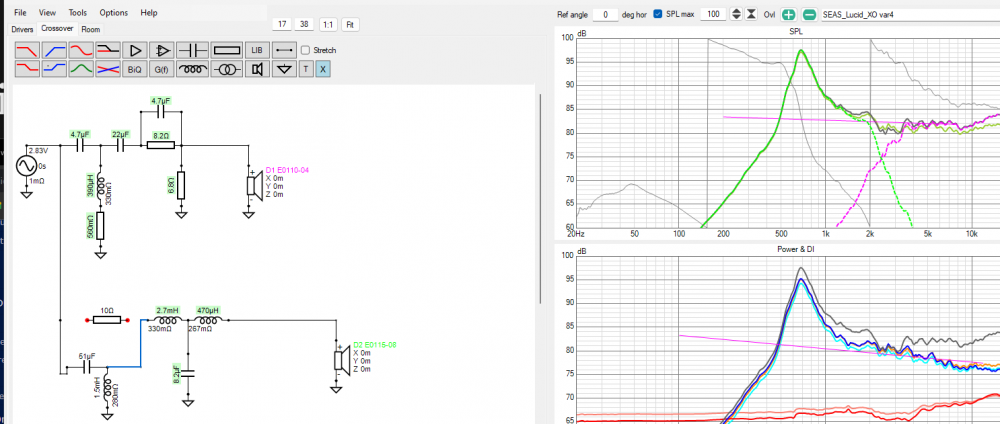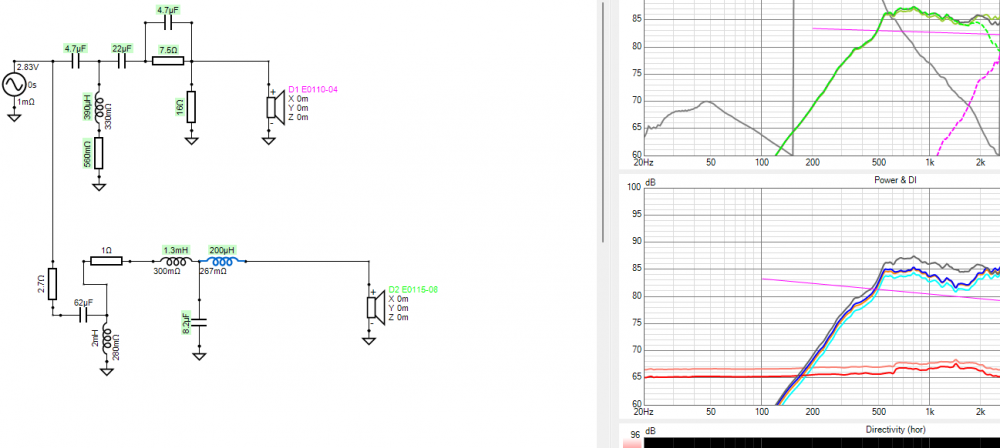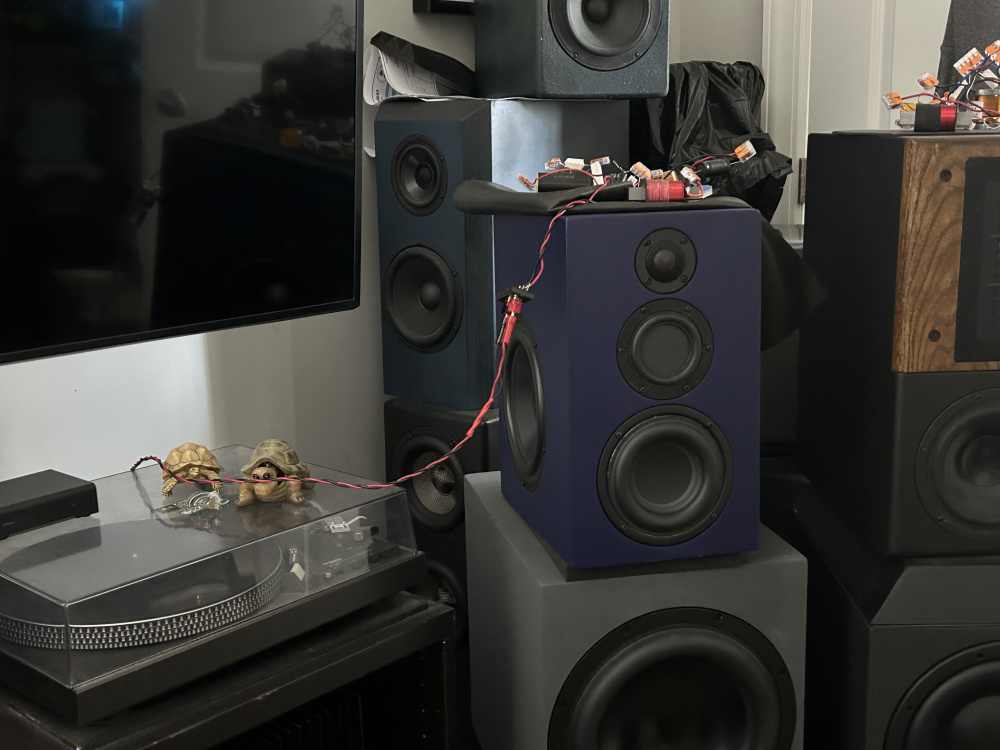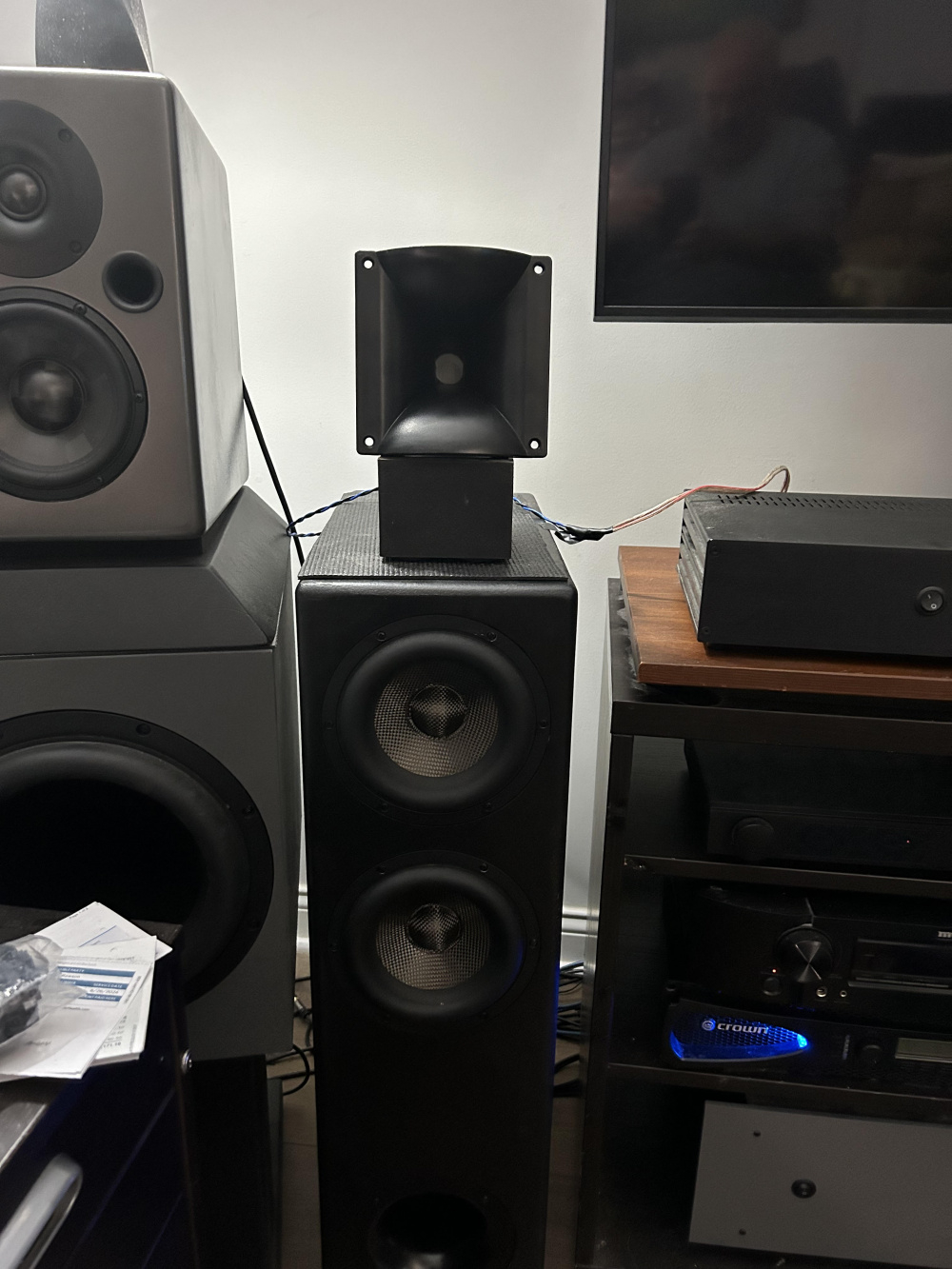Site Links
Howdy, Stranger!
It looks like you're new here. If you want to get involved, click one of these buttons!
Quick Links
Categories
In this Discussion
Who's Online (0)
Random Questions
Was hoping for a universal thread for quick hitter questions...
With sealed midrange where rolloff to a -3db of like mid 100's, how much does IMD kick in if no filter applied? Perhaps a cheat question for indy25. Like I know not want to apply 80hz sonic pressure to driver that just not gonna give it to you, but how much can one use the smalled sealed nature to cut off low end response, or does pressures still create major distortion
Experience with various 8" ers, subs too. Seems many of the sub with extended range end up in the 82-84db sensitive range. Know many have dabbled with many and depends greatly on application. Debting on grabbing RSS210's (8 inch HF dayton ref sub), like not need more sub, but has some reach. Versus say the SB poly 8" sub, some wavecor offerings, or just non sub designated SB alum 8's. Myself, I tend to like metal bass drivers, some have lower distortion which sometimes make feel like less bass there but then realize it's just cleaner.
Anyone dabble with the 3.5 inch tectronic? made mistake and bought pair and was horrified by the on axis response. Like phase flip at 1.5k, huge dip. Then took few crude diff angle measurements and say it shift but made damn near impossible to simulate in software. Seemed like work with visual high Q dip, but when created xover based on that it was horrible and I said F it, on to diff mid as I'm not up for that.
When working on 3 way, add the high pass to a mid/woofer, the hump up, perhaps from using too narrow bandwidth, but curious what that called? reactance?... f'd up as educated as EE and should be able figure out but think it's easier to just ask and someone experienced surely knows what I'm refering to. Also, are there hints from that kind of simulation that indicate driver not a good mid candidate. I ran into problem with my spendy sdc entry where get mid look right, though ended up with tweet crossed with 2nd order electrical and gave the shouty tweet syndrome despite tweets Fs being uber low.
That all for now, but sure there are always curiosities that experienced people can answer if question framed close enough.

Comments
I love the 3.5 Tectonic driver. Send them to me please.
If you are talking about the Tectonic TEBM65C20F-8 3-1/2", then I see what you mean about the huge dip. I'm working on a speaker that uses 4 of the Tectonic TEBM46 3" drivers per side. This particular BMR does not have a huge on-axis dip like that. I wonder why. The drivers look similar. I have had very good luck with the TEBM46 on two other builds. Very smooth on and off axis. I will be using 4 of these little buggers per side on my next build because I want to push the xover down to about 100Hz. A single or quad set of TEBM46's will only get me down to about 350Hz in a sealed cabinet, but if I use a vented alignment, they will easily get down to 100Hz. Then I will use an active high pass crossover to avoid the huge bass reflex impedance peaks in the 50 to 200Hz region.
I know others will have better answers but here are my lowbrow answers (If I'm understanding the questions properly)
1: My build I am running the main FR wide open in a shared vented enclosure. It sounds pretty great sofar to me. I figure just have to ignore the possible downsides and try it to hear the outcome. That is what the challenge is for IMO. The reason I didn't try the sealed FR with a woofer was I wasn't sure how I'd deal with both baffle step and the drop out of the FR's output. Ben's recent stepped DVC idea has me scratching my chin though.
2: Not sure what the question is.. 8" seems like a nice balance between bass extension while still being able to mate up to just about any mid... and sometimes tweeter. Like Ben's Zingers adapting the sd215a-88 to a tweeter. The RS subs have a bunch of copper in the motor structure that appears to delay the impedance from going to the moon immideately, allowing it to reasonably work with a passive lowpass to a mid.
3: Ive not heard it but it seems to be one of those cases of just put a bag over the FR graph and enjoy it's positive capabilities. Ignorance is bliss.
4: IDK what it is called. Assuming you mean the effect of the resonance peak on the highpass? Seems it can be reduced with a parallel resistor (doesn't have to be low value, same value as the resonance peak value will halve the effect), or eliminated with a series LCR (in parallel with the driver). Sometimes the R can be omitted if well enough below passband.
Dangit! John beat me to it. I have 2 in a ammo can for a bluetooth speaker, surprisingly good. What you are seeing in the response is the drivers transition from pistonic movement to surface vibrations. Could notch it but I doubt it's needed.
Some of John's wonderful work:
https://projectgallery.parts-express.com/speaker-projects/bmr-3l/
The gain in the midrange of a 3way is called "bandpass gain". I would be careful about how far you limit the bandwidth of the midrange approaching that of a "filler driver", or a few hundred Hz. Having 1-3dB of BPgain is more reasonable to deal with than +6dB on a filler.
InDIYana Event Website
Ah yeah, listened to a little bit just full range hooked up to get rough idea of how sound, was surprised had some tzzz tzzz, even though plan was to use a mid 4-500 to 4k ish. A small 14L 3 way, paired with TB 5 sub and ND25ti. I was getting the same notch in the response and thought arrived at a frd to bring into vcad but hooked up first derived network and sounded wrong then I got fed up knowing I was entering into realm where my measurements not good enough to track in simulations and visa versa.
Was intrigued by the driver as yearn for off axis bliss, or at least the thought stuck in head that I am. Maybe I'll try some more. Did come to grips several learning builds ago that yeah that solely shooting for a 'perfect' on axis does not make a good speaker. Think more than anything see the common naive jumping to basic active xover will disappoint more often than not.
Really need to migrate my playroom to basement where more space.
On the mid, had come thing think bp gain was the portions added from the dwindling contribution from the tails of drivers above and below (freq wise), to the point where sometimes see the mid response hovering db or 2 below the overall response. Attaching rough 2 pics to demo what see in sims, where seemed it just matter of damping. Though in practice, would use the opportunity to bring up the mid-tweet since not need to push down much for BSC, get some output back. So lower coil values and the dominoes of adjusting. Anyway, pics this example taking a provided/suggested passive design for 2 way.


Doh, think trying to explain made me realize the phenomia. The big 2.7 coil downward opposing the high pass creates the excessive humping. Like the closeness of the high pass and low shelf effects So reducing the coil, where before thinking to get back some gain by removing some 'bsc' in effect reduce the hump, kind of like this

I built these with the Tectonic 3.5" and they sound fine. The blip in the response is there but pretty small. I still ended up with +/- 5db. I built them for my wife to use as computer speakers.
https://diy.midwestaudio.club/discussion/1706/little-ones
Ron
Hopefully get a chance to tinker with next few days - did have same conclusion that the weird 1.7K dip something to ignore as couldn't hear the weirdness when listening to full range. Think I just freaked out that modeled xover at trial time seemed bad, where think my frd file not cutting it and gave up to quickly before consulting ya'll seasoned peeps - that's why love this forum
Add more random question, #6?.... Would be interesting to make it a running thread on little one hitters, but anyway. So, often use vitiuix cad's enclosure modeler to make stab at bass alignment. Seems to work pretty well but find some fine tuning needed which is fine and expected. But I wanna ask about intuitive experience... when have a 2 way, and bass on woofer gets a little slappy, hope someone knows what I'm talking about... is that often from tuning too low? Or at least that is what i found in practical experimenting. Noobs like me eager to stretch response to lowest F3, not fully accounting for turbulence, xmax etc. Seems getting that nice even bass response can make or break speaker's appeal. With the thugs reborn (vifa m18 + grs midtweet planar), found was better to shorten port for higher F3 so sounded "tighter", then when cranked up was happy that low reach was still there.
Thanks much for pointing out John's PE gallery entry and affirming that could work around the dip. More or less took the xover design, applied to to my measurements since slightly diff tweeter and very minor adjustments based on measurements I had. Added 30uf and shunt resistor before the tectronic filter and 3.3/100uf on the TB5sub. The notch makes sense, now things sound pretty good. Little bit of excessive tzzz tzzz from the Ti ND25's, need to take some measurements to check levels not whacked. Have dem ND28F's, but see too many complain how dull those are. Now they are like little party speakers with clear n present mids.

Sad I couldn't make it to CSS event, was planning to go and bring wavecor-ceramidome-sb12cac-satori9.5 3 way, more for validation that sound 'right' as have been in daily duty in fam room, but had some family things going on.
Question for now is why do these sound good to me... perhaps genre's listening to make it too easy, really need to test some vocals. Feels like the dual epic's give more radiation of the 500-1000hz. Crossed over at about 1300hz via minidsp, tweeter is prv titatium that I cant seem to find on PE right now. They were about 40 bucks a pop, in a later order picked up some plain horns. Orig bought the compression drivers to mate with 12 inch dayton pro coax, meh... not worth the effort so posted on ebay. But this epic7 dual and horn loaded compression driver seems to fill some boxes - and then i worry i have the wrong boxes, like the combo makes me think of early 90's car audio of subs with some piezo horn tweets

It would have been nice if you had been able to come but family is much more important, good on you for taking care of family.
Look forward to seeing you at the next one.
Looks like you've made yourself a modern Klipsch HT style tower. And I bet yours are voiced better too. Now I can't help but imagine them all in the same tower. Would be kinda badass IMO. As if a klipsch tower took ALL the sterroids!
When I've heard the epiques used in 2-ways the midrange sounded a bit vague to me. Though that is crossing at typical dome tweeter range. That vagueness could go away the lower it is crossed. IDK
More random questions...
1 - Been playing with various builds, sometimes tricky to reach conclusion that have bass 'right'. In a 2 way, adjustment of the coil size to get more bass but walk line of muddying the mids from excessive 100-300Hz (?) as well as various listening levels. But, if ever get that slappy bass sound on some genre's is that indicator that too big coil, or more from the tuning? Almost that sound perception of power lacking. Aware answer could be well it depends. But wanting to know if there some general observations from the seasoned vets.
2 - Often find self inspecting the jagged (reflections) larger or no gate response gleaning more at the average trend to see how levels are, especially on 3 ways. What are flaws if look at nearfield of woofer and mid to inspect slopes of filter? Aware of the measurement accurate to X freq based on cone diameter and the said difference on baffle effects absent. Seems like my merging skills and factoring in baffle still suspect and thus curious how nearfield could be used to 'see' the illusive 100-400Hz filter behavior better.
Though I've moved speaker measuring to basement with 9ft ceilings, did not gain much on gating window as hoped.